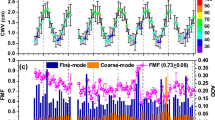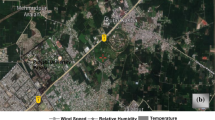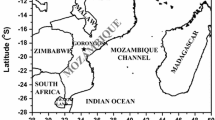Abstract
In this paper, the variations of aerosol properties due to crackers burning during Diwali event (11th–18th 2012) over mega city Delhi were investigated. The sky radiometer POM-2 aerosol optical property data from Skynet-India along with ambient air pollution data were critically analyzed. The aerosol optical depth (AOD) at 500 nm was 1.60 on 13th November, the Diwali day, and its value a maximum of 1.84 on 16th November. Due to stable atmosphere over Delhi during post Diwali, aerosols accumulate and remain in the atmosphere for longer time, which leads to higher AOD on 16th November. A lower value of single-scattering albedo (SSA) was observed at a longer wavelength (1020 nm) during the entire period that clearly indicates the dominance of absorbing-type black carbon aerosol. SSA showed a steep decrease after 16th November. Asymmetry parameter decreased to a maximum of 0.79 for the shorter wavelength at 340 nm and 0.632 is reported at the higher wavelength 1020 nm. Asymmetry parameter showed a decrease in value just after Diwali on 14th November, this suggesting the dominance of fine-mode aerosol from anthropogenic activities. The lowest value of the refractive index (1.4527) on 14th and 15th November indicates the higher loading of absorbing-type aerosol which may be associated with firecracker burning of Diwali festival. The significant correlation with the value of r = 0.9 was observed between sky radiometer and MODIS AOD with a standard deviation of 0.31 and an RMSE of 0.17 during the event. Radiative forcing and heating rate were estimated using SBDART. The maximum average concentrations 2641 and 1876 μg/m3 of PM10 and PM2.5, respectively, were observed on the Diwali night. A highest of 109 ppb surface ozone was reported in the night at 23:00 IST, which can be attributed to burning of the firecrackers.










Similar content being viewed by others
References
Aksu A (2015) Sources of metal pollution in the urban atmosphere (a case study: Tuzla, Istabul). J Environ Health Sci Eng 13(1):79–89
Ali MA, Assiri M, Ramzah D (2017) Seasonal aerosol optical depth (AOD) variability using satellite data and its comparison over Saudi Arabia for the period 2002–2013. Aerosol Air Qual Res 17:1267–1280
Angstrom A (1964) The parameters of atmospheric turbidity. Eppley Found Res 1:64–75
Attri AK, Kumar U, Jain VK (2001) Microclimate formation of ozone by firecrackers. Nature 411(6841):1015
Badarinath KVS, Kharol SK, Kaskaoutis DG, Sharma AR, Ramaswamy V, Kambezidis HD (2010) Long-range transport of dust aerosols over the Arabian Sea and Indian region—a case study using satellite data and ground-based measurements. Global Planet Change 72(3):164–181
Barman SC, Singh R, Negi MPS, Bhargava SK (2008) Ambient air quality of Lucknow City (India) during use of firecrackers on Diwali Festival. Environ Monit Assess 137:495–504
Bisht DS, Dumka UC, Kaskaoutis DG, Pipal AS, Srivastava AK, Soni VK, Tiwari S (2015) Carbonaceous aerosols and pollutants over Delhi urban environment: temporal evolution, source apportionment and radiative forcing. Sci Total Environ 521–522:431–445
Chatterjee A, Sarkar C, Adak A, Mukherjee U, Ghosh SK, Raha S (2013) Ambient air quality during Diwali festival over Kolkata-a mega-city in India. Aerosol and Air Quality Research 13(13):1133–1144
Clark H (1997) New directions light blue touch paper and retire. Atmos Environ 31(17):2893–2895
Darga SS, Yogesh K, Mitra D (2006) Variability of aerosol optical depth and aerosol forcing over India. Adv Space Res 37(12):2153–2159
Deng T, Deng X, Li F, Wang S, Wang G (2016) Study on aerosol optical properties and radiative effect in cloudy weather in the Guangzhou region. Sci Total Environ 568:147–154
Devara PCS, Vijayakumar K, Safai PD, Raju MP, Rao PSP (2015) Celebration-induced air quality over a tropical urban station, Pune, India. Atmos Pollut Res 6:511–520
Draxler RR (1998) An overview of the HYSPLIT_4 modelling system for trajectories, dispersion, and deposition. Aust Meteorol Mag 47:295–308
Dubovik O, King MD (2000) A flexible inversion algorithm for retrieval of aerosol optical properties from Sun and sky radiance measurements. J Geophys Res 105(D16):20673–20696
Dumka UC, Saheb SD, Kaskaoutis DG, Kant Y, Mitra D (2016) Columnar aerosol characteristics and radiative forcing over the Doon Valley in the Shivalik range of northwestern Himalayas. Environ Sci Pollut Res 23(24):25467–25484
Eck TF, Holben BN, Reid JS, Dubovik O, Smirnov A, O’Neill NT, Slutsker I, Kinne S (1999) Wavelength dependence of the optical depth of biomass burning, urban, and desert dust aerosols. J Geophys Res 104(D24):31333–31349
Godri KJ, Green DC, Fuller GW, Dall’osto M, Beddows DC, Kelly FJ, Mudway IS (2010) Particulate oxidative burden associated with Firework activity. Environ Sci Technol 44(21):8295–8301
Hoppel WA, Fitzgerald JW, Larson RE (1985) Aerosol size distributions in air masses advecting off the east coast of the United States. J Geophys Res 90(D1):2365–2379
Jacobson MZ (2000) Implications for global direct forcing of aerosols Well-mixed. Geophys Res Lett 27(2):217–220
Kaskaoutis DG, Sinha PR, Vinoj V, Kosmopoulos PG, Tripathi SN, Misra A, Singh RP (2013) Aerosol properties and radiative forcing over Kanpur during severe aerosol loading conditions. Atmos Environ 79:7–19
Kaufman YJ, Setzen A, Ward D, Tanre D, Holben BN, Menzel P, Rasmussen R (1992) Biomass burning airborne and spaceborne experiment in the Amazonas (Base-a). J Geophys Res Atmos 97(D13):14581–14599
Kharol SK, Badarinath KVS, Sharma AR, Mahalakshmi DV, Singh D, Prasad VK (2012) Black carbon aerosol variations over Patiala city, Punjab, India—a study during agriculture crop residue burning period using ground measurements and satellite data. J Atmos Solar Terr Phys 84:45–51
Kulshrestha UC, Nageswara Rao T, Azhaguvel S, Kulshrestha MJ (2004) Emissions and accumulation of metals in the atmosphere due to crackers and sparkles during Diwali festival in India. Atmos Environ 38(27):4421–4425
McCartney EJ, Hall FF (1977) Optics of the atmosphere: scattering by molecules and particles. Phys Today 30(5):76
Mor V, Dhankhar R, Attri SD, Soni VK, Sateesh M, Taneja K (2017) Assessment of aerosols optical properties and radiative forcing over an Urban site in North-Western India. Environ Technol 38(10):1232–1244
More S, Pradeep Kumar P, Gupta P, Devara PCS, Aher GR (2013) Comparison of aerosol products retrieved from AERONET, MICROTOPS and MODIS over a Tropical Urban City, Pune, India. Aerosol Air Qual Res 13:107–121
Nakajima T, Tonna G, Rao R, Boi P, Kaufman Y, Holben B (1996) Use of sky brightness measurements from ground for remote sensing of particulate polydispersions. Appl Opt 35(15):2672–2686
Nichol JE, Bilal M (2016) Validation of MODIS 3 km resolution aerosol optical depth retrievals over Asia. Remote Sens 8:328
Nidhi, Jayaraman G (2007) Air quality and respiratory health in Delhi. Environ Monit Assess 135:313–325
Parkhi N, Chate D, Ghude SD, Peshin S, Mahajan A, Srinivas R, Beig G (2016) Large inter annual variation in air quality during the annual festival “Diwali” in an Indian megacity. J Environ Sci (China) 43:265–272
Pervez S, Chakrabarty RK, Dewangan S, Watson JG, Chow JC, Matawle JL (2016) Chemical speciation of aerosols and air quality degradation during the festival of lights (Diwali). Atmos Pollut Res 7(1):92–99
Pongpiachan S, Hattayanone M, Suttinun O, Khumsup C, Kittikoon I, Hirunyatrakul P, Cao J (2017) Assessing human exposure to PM10-bound polycyclic aromatic hydrocarbons during firecrackers displays. Atmos Pollut Res 8(5):816–827
Pöschl U (2005) Atmospheric aerosols: composition, transformation, climate and health effects. Angew Chem Int Ed 44:7520–7540
Ramanathan V, Feng Y (2009) Air pollution, greenhouse gases and climate change: global and regional perspectives. Atmos Environ 43:37–50
Ricchiazzi P, Yang S, Gautier C, Sowle D (1988) SBDART: a research and teaching software tool for plane-parallel radiative transfer in the earth’s Atmosphere. Bull Am Meteor Soc 10:2101–2114
Schaaf CB, Gao F, Strahler AH, Lucht W, Li X, Tsang T, Roy D (2002) First operational BRDF, albedo nadir reflectance products from MODIS. Remote Sens Environ 83(1–2):135–148
Sharma AR, Kharo SK, Badarinath KVS, Singh D (2010) Impact of agriculture crop residue burning on atmospheric aerosol loading—a study over Punjab State, India. Ann Geophys 28(2):367–379
Shaw GE (1988) Aeroso size-temperature relationship. Geophys Res Lett 15(2):133–135
Simha CP, Devara PCS, Saha SK (2013) Aerosol pollution and its impact on regional climate during Holi festival inferred from ground-based and satellite remote sensing observations. Nat Hazards 69:889–903
Singh RP, Dey S, Tripathi SN, Tare V (2004) Variability of aerosol parameters over Kanpur, northern India. J Geophys Res 109(D23):1–14
Singh BP, Srivastava AK, Tiwari S, Singh S, Singh RK, Bisht DS, Srivastava MK (2014) Radiative impact of firecrackers at a tropical Indian location: a case study. Adv Meteorol 2014:1–8
Singh A, Bloss WJ, Pope FD (2015) Remember, remember the 5th of November; Gunpowder, particles and smog. Weather 70(11):320–324
Singh A, Bloss WJ, Pope FD (2017) 60 years of UK visibility measurements: impact of meteorology and atmospheric pollutants on visibility. Atmos Chem Phys 17(3):2085–2101
Takemura T, Nakajima T (2002) Single-scattering albedo and radiative forcing of various aerosol species with a global three-dimensional model. J Clim 15(4):333–352
Torres O, Bhartia PK, Herman JR, Ahmad Z, Gleason J (1998) Derivation of aerosol properties from satellite measurements of backscattered ultraviolet radiation: theoretical basis. J Geophys Res 103(D14):17099–170110
White AB, Senff CJ, Keane AN, Darby LS, Djalalova IV, Ruffieux DC, Goldstein AH (2006) A wind profiler trajectory tool for air quality transport applications. J Geophys Res 111(D23):1–11
Zarzana KJ, Hann DOD, Freedman MA, Hasenkopf CA, Tolbert MA (2012) Optical properties of the products of α-dicarbonyl and amine reactions in simulated cloud droplets. Environ Sci Technol 46(9):4845–4851
Acknowledgements
The authors sincerely thank Dr. K. J. Ramesh, Director General of Meteorology, India Meteorology Department, for encouraging to carryout this work. We also acknowledge NOAA and NASA for providing online HYSPLIT back trajectory model and the MODIS L2 AOD products. We thank three anonymous reviewers for their constructive comments and suggestions which help us for further improvement in the manuscript.
Author information
Authors and Affiliations
Corresponding author
Rights and permissions
About this article
Cite this article
Sateesh, M., Soni, V.K. & Raju, P.V.S. Effect of Diwali Firecrackers on Air Quality and Aerosol Optical Properties over Mega City (Delhi) in India. Earth Syst Environ 2, 293–304 (2018). https://doi.org/10.1007/s41748-018-0054-x
Received:
Accepted:
Published:
Issue Date:
DOI: https://doi.org/10.1007/s41748-018-0054-x




